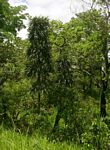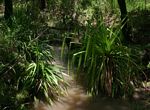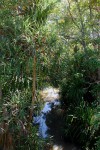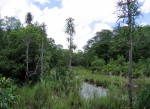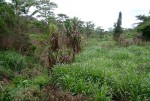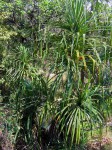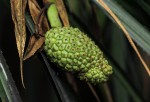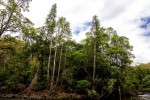Pandanus livingstonianus
Selected images: Click on each image to see a larger version and details of the record View all images (12)
Detailed records: Display species records QDS maps by: Google Maps Point records by Google Maps
Species details: Click on each item to see an explanation of that item (Note: opens a new window)
| Synonyms: |
Pandanus gasicus Huynh. Pandanus globulatus Huynh. Pandanus mosambicus Huynh. Pandanus petersii Warb. Pandanus serrimarginalis Huynh. |
| Common names: | Screw-pine (English) |
| Frequency: | Locally common |
| Status: | Native |
| Description: |
Small tree. Stem pale brown, supported by numerous stilt roots; stem and roots spiny. Young trees palm-like with a single terminal tuft of leaves, older trees shortly branched and pine-like with many terminal tufts. Leaves in 1-many terminal tufts of 3 spirally arranged ranks, long and linear strap-shaped, 1 m or more long, shiny bright green to dark olive-green, paler below; margin armed with backward-facing hooked prickles. Flowers unisexual; male flowers in branched, spikes, 15-20 cm long, creamy-white with conspicuous spathe-like bracts; female flowers greenish-cream in short compact spikes. Fruit small, fleshy in cone-like clusters up to 12 × 7cm. |
| Type location: |
Mozambique |
| Notes: | |
| Derivation of specific name: | livingstonianus: named after the legendary Scottish explorer David Livingstone (1813-1873). |
| Habitat: | Along river banks and in swamps. |
| Altitude range: (metres) | Up to 900 m |
| Flowering time: | Oct |
| Worldwide distribution: | Mozambique, northeastern Zambia and D.R. Congo; probably also in Angola. |
| FZ divisions: | N,Z,MS,GI,M |
| Growth form(s): | Tree. |
| Endemic status: | |
| Red data list status: | |
| Insects associated with this species: | |
| Spot characters: | Display spot characters for this species |
| Images last updated: | Thursday 26 December 2019 |
| Literature: |
Beentje, H.J. (2009). Pandanaceae Flora Zambesiaca 12(2) Pages 149 - 153. (Includes a picture). Beentje, H.J. (2016). Pandanaceae Flore d'Afrique Centrale Nouvelle Serie Botanic Garden Meise, Belgium Pages 9 - 11. (Includes a picture). Burrows, J.E., Burrows, S.M., Lötter, M.C. & Schmidt, E. (2018). Trees and Shrubs Mozambique Publishing Print Matters (Pty), Cape Town. Page 43. (Includes a picture). Coates Palgrave, K. (revised and updated by Meg Coates Palgrave) (2002). Trees of Southern Africa 3rd edition. Struik, South Africa Page 96. (Includes a picture). Da Silva, M.C., Izidine, S. & Amude, A.B. (2004). A preliminary checklist of the vascular plants of Mozambique. Southern African Botanical Diversity Network Report No. 30 Sabonet, Pretoria Page 129. Parker, T. (2023). Common Trees of Mozambique The Tree Press, Austin, Texas, USA Pages 306 - 307. (Includes a picture). Phiri, P.S.M. (2005). A Checklist of Zambian Vascular Plants Southern African Botanical Diversity Network Report No. 32 Page 126. |
Other sources of information about Pandanus livingstonianus:
Our websites:
Flora of the DRC: Pandanus livingstonianusFlora of Zambia: Pandanus livingstonianus
External websites:
African Plants: A Photo Guide (Senckenberg): Pandanus livingstonianusAfrican Plant Database: Pandanus livingstonianus
BHL (Biodiversity Heritage Library): Pandanus livingstonianus
EOL (Encyclopedia of Life): Pandanus livingstonianus
GBIF (Global Biodiversity Information Facility): Pandanus livingstonianus
Google: Web - Images - Scholar
iNaturalist: Pandanus livingstonianus
IPNI (International Plant Names Index): Pandanus livingstonianus
JSTOR Plant Science: Pandanus livingstonianus
Mansfeld World Database of Agricultural and Horticultural Crops: Pandanus livingstonianus
Plants of the World Online: Pandanus livingstonianus
Tropicos: Pandanus livingstonianus
Wikipedia: Pandanus livingstonianus
